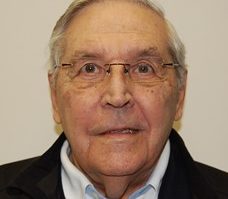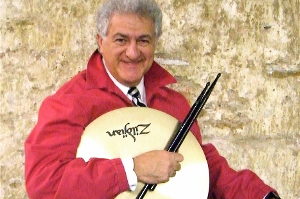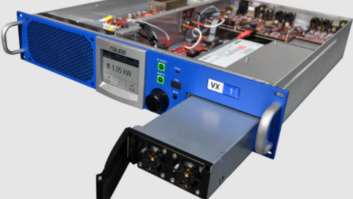During the last few decades, a number of broadcast-related museums have sprung up across the country — locations in California, Connecticut, Minnesota, Maryland, New York, West Virginia and Rhode Island come to mind, just to name a few.

The National Voice of America Museum of Broadcasting is located in this former Voice of America relay station building in Bethany, Ohio.
This interest in exhibiting older gear may in part be due to the graying of many broadcasting’s players, and perhaps the comfort level brought by being around some of the hardware that made coast-to-coast and round-the-world transmissions possible before satellites, fiber and computers. Regardless, there are a goodly number of such institutions and the number seems to be growing.
Three new entries have set up shop in a historic setting in central Ohio. These separate but thematically connected museums are under one roof on Tylersville Road, just down the way from Powell Crosley Jr.’s fabled WLW transmitter site with its Blaw-Knox diamond antenna and 500,000 Watt transmitter.
The site that the museums occupy was created and owned by the Crosley broadcasting empire, later becoming federal property when the government took over the shortwave broadcasting operations that Crosley launched to help America counter wartime propaganda coming from Nazi Germany. The new institution officially is the National Voice of America Museum of Broadcasting and is on the former campus of what was once the VOA’s Bethany Relay Station.
THREE MUSEUMS, ONE ROOF
The museums — the Gray History of Wireless Museum, the National Voice of America Museum of Broadcasting and the Media Heritage collection — occupy a relatively small portion of a cavernous building that was constructed nearly 70 years ago and originally housed several custom-built 200 kW HF transmitters.

Much radio (and television) history is captured in the artifacts on display in the Gray History of Wireless Museum.
The government decided to end VOA program relay operations from Bethany in 1994, and the station building and a portion of the surrounding antenna farm acreage were deeded over to the West Chester (Ohio) Township for use as a park. The shortwave station’s antenna farm — numerous rhombics and curtain arrays — were toppled, but the transmitter and operations building was allowed to remain, with the three historical organizations being given space to exhibit their artifacts.

This 1960s vintage Collins 821A1 250 kW transmitter once powered VOA HF broadcasts from the Bethany relay station. It’s on display as part of the National Voice of America Museum of Broadcasting collection.
The Gray History of Wireless Museum has been part of the greater Cincinnati landscape for several decades. It consists of a large collection of wireless artifacts amassed by one G.J (Jack) Gray during his lifetime as a ship’s radio officer in the 1910s, and later as an employee of the Crosley radio empire.
After Gray’s death in 1970, the collection was relocated from his garage to the Crosley Telecommunications Center, location of Cincinnati’s PBS member station, WCET, and public radio station, WGUC. When the former VOA space became available, the Gray collection was relocated there.
It is organized, timeline fashion, into an easy-to-follow series of displays. It’s not just about radio, as there are a number of television artifacts too. One of the more notable is a large power klystron that’s been cut away to display its inner workings. The 430-pound tube came from Washington UHF television operation WDCA(TV) and logged nearly 48,000 hours before it was retired in 1985.
QUARTER-MEGAWATT FLAMETHROWER
From an organizational and geographic standpoint, the next entity at the site is the one that takes its name from the former government broadcasting operation housed there. It’s the National Voice of America Museum, with its centerpiece exhibits being a surviving Collins 821A1 250 kW shortwave transmitter (once there were three at the facility) and the former station’s master control room, which has been left largely as it was in late 1994.

This ‘board’ dates from the 1920s and provides a good example of what an broadcast station’s audio mixer looked like 80 or so years ago. While not totally original — VU meters didn’t appear until the late 1930s — it does contain a number of components dating to the ’20s. It’s one of many Media Heritage Museum broadcasting artifacts.
Even though the antennas to the rear of the building have been demolished, the massive outdoor RF “routing switcher” — part of the original 1942 wartime installation and used to direct transmitter feeds to the facility’s various antennas — is still in place, complete with creosoted telephone pole supports and “heavy iron” contactor gear.
LIGHTS, PHOTOS, COSTUMES!

These costumes were once worn by ‘Uncle Al’ and ‘Captain Windy’ in a long-running Cincinnati children’s daily television show. The show began on WCPO in 1950 and continued until the mid-1980s. The costumes are on display at the Media Heritage Museum.
The Media Heritage museum is a combination of broadcasting hardware and informational displays about the “software” side of radio and television — its performers and programs.
Co-founder and President Mike Martini explained, “There are several museums dedicated to radios, microphones, and equipment; and because we’re in the same building as the Gray Museum, we wanted to go beyond that and preserve the memory of the performers, the writers, the technicians, and others who helped to put the shows on the air.
“Most other places are into equipment, but our primary focus is on Cincinnati’s radio and television history.”
Even though the programming side of broadcasting is emphasized here, there’s certainly enough in the collection to whet the hardware lover’s appetite. Relics include an very large Ampex quadruplex videotape machine, an RCA 16 mm telecine projector and studio color camera, an early weather radar display, transcription turntables, audio consoles, and most remarkably, a very early audio control “board” that is said to have been used originally at Cleveland’s WTAM.
Photos of hundreds of performers from Cincinnati broadcasting’s heyday line a wall of the space, and there’s a display case housing costumes worn by performers “Uncle Al” and “Captain Windy” on a local children’s daily television show that enjoyed a three-and-a-half decade run.
Perhaps the most visible artifact in the Media Heritage collection is a white Wurlitzer 1787 organ console — the “control surface” of an instrument found in hundreds of showplace movie theatres and larger radio stations and network operations during the 1930s and beyond. It’s awaiting restoration and reconnection to hundreds of pipes. And although this console came from a movie house, one of the ranks of pipes acquired for the project was once part of the fabled Crosley WLW “Moon River” organ. Martini says plans are being worked out for a computerized control system to be added to the organ so that demonstrations on demand can be part of the Media Heritage tour.

While this ‘mighty Wurlitzer’ organ originally came from a 1920s ‘movie palace’ and not a radio station, in later years it was fitted with a rank of organ pipes from the WLW ‘Moon River’ Wurlitzer organ. The Media Heritage Museum has plans to restore it to playing condition and provide museum visitors with a taste of what live radio organ interludes sounded like.
“Our goal is to give people the opportunity to hear a big Wurlitzer organ played on a regular basis, either by a live performer, or played by computer.”
Hundreds of artifacts and exhibits await discovery in this unique museum setting; if your travels take you anywhere near Cincinnati, a visit should be on your must-do list. Where else can you tour a facility where a monster transmitter that beamed programming around the world coexists with performers’ costumes?












